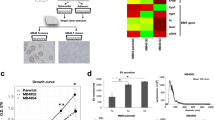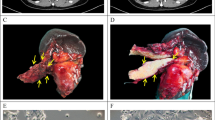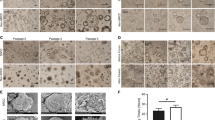Abstract
Determination of the differences between cell lines which are derived from a primary tumour and a disseminated metastatic lesion from the same patient may aid in elucidating the factors associated with disseminated metastases. We report on the establishment and characterisation of two new scirrhous gastric cancer cell lines, designated OCUM-2M and OCUM-2D, derived from a 49-year-old female. OCUM-2M was derived from a primary gastric tumour, and OCUM-2D was derived from a sample of disseminated metastasis. The two cell lines were derived from the same patient. We investigated biological differences between the two cell lines to study mechanisms involved in disseminated metastasis. The growth activity of OCUM-2D cells as determined by doubling time and tumorigenicity was greater than that of OCUM-2M cells. The level of epidermal growth factor receptor (EGFR) expression in OCUM-2D cells was about twice that of OCUM-2M cells and the growth of OCUM-2D cells was stimulated more by epidermal growth factor (EGF) than that of OCUM-2M cells. The invasive activity of OCUM-2D cells was higher than that of OCUM-2M cells and was increased after addition of transforming growth factor-beta 1 (TGF-beta 1). An increase in the number of attached and spreading cells was found following the addition of 10 ng ml-1 TGF-beta 1. These findings suggest that high growth and invasive activity may play an important role in disseminated metastasis and that EGF and TGF-beta 1, which affect the growth and invasive activity of OCUM-2D cells, might be factors associated with metastasis in scirrhous gastric carcinoma. The two cell lines OCUM-2M and OCUM-2D should be beneficial for analysing mechanisms of tumour progression.
This is a preview of subscription content, access via your institution
Access options
Subscribe to this journal
Receive 24 print issues and online access
$259.00 per year
only $10.79 per issue
Buy this article
- Purchase on Springer Link
- Instant access to full article PDF
Prices may be subject to local taxes which are calculated during checkout
Similar content being viewed by others
Author information
Authors and Affiliations
Rights and permissions
About this article
Cite this article
Yashiro, M., Chung, Y., Nishimura, S. et al. Establishment of two new scirrhous gastric cancer cell lines: analysis of factors associated with disseminated metastasis. Br J Cancer 72, 1200–1210 (1995). https://doi.org/10.1038/bjc.1995.486
Issue Date:
DOI: https://doi.org/10.1038/bjc.1995.486
This article is cited by
-
The significance of scirrhous gastric cancer cell lines: the molecular characterization using cell lines and mouse models
Human Cell (2018)
-
Importance of human peritoneal mesothelial cells in the progression, fibrosis, and control of gastric cancer: inhibition of growth and fibrosis by tranilast
Gastric Cancer (2018)
-
Plasma microRNA-103, microRNA-107, and microRNA-194 levels are not biomarkers for human diffuse gastric cancer
Journal of Cancer Research and Clinical Oncology (2017)
-
Lysyl oxidase is associated with the epithelial–mesenchymal transition of gastric cancer cells in hypoxia
Gastric Cancer (2016)
-
Bone marrow-derived stromal cells are associated with gastric cancer progression
British Journal of Cancer (2015)



